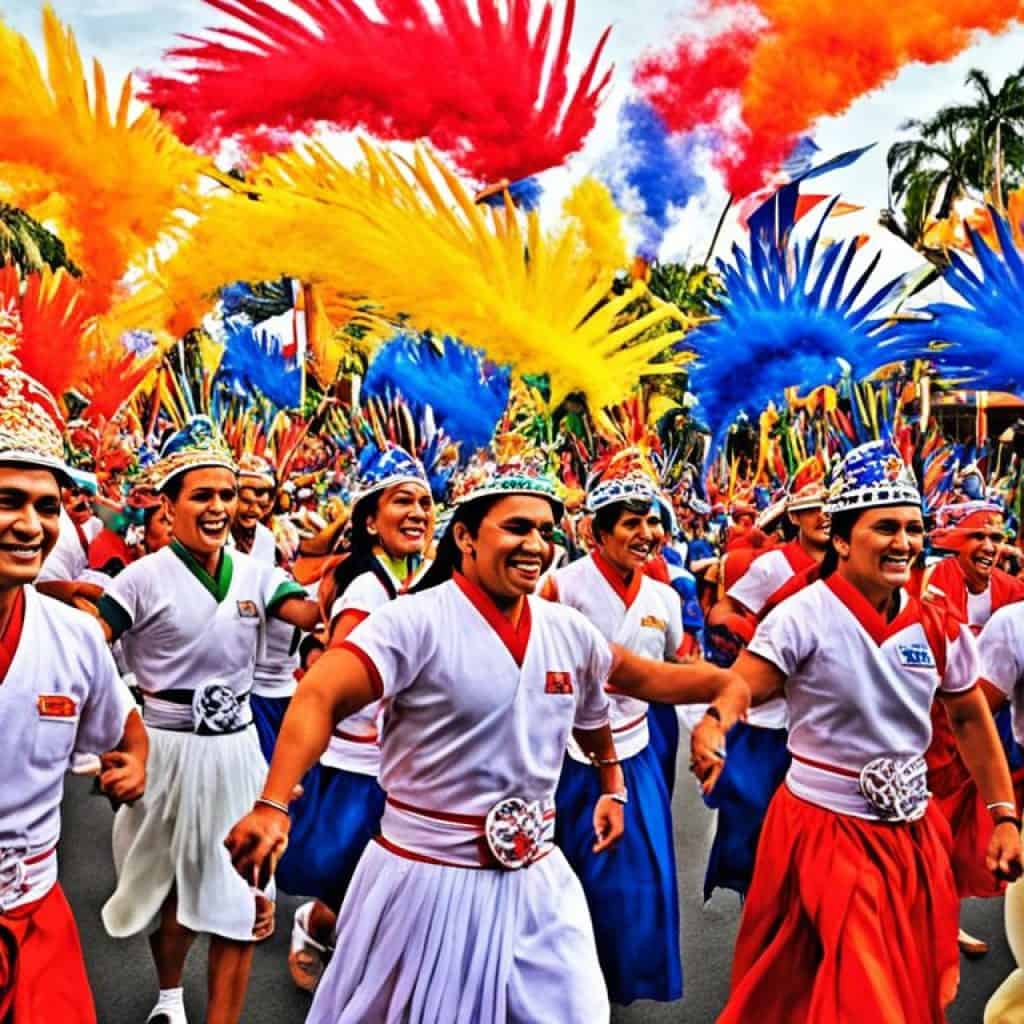Did you know that the Philippines, a nation with rich linguistic diversity, has an official national language? In this article, we will explore the fascinating history and evolution of the Filipino language, the national language of the Philippines. Get ready to dive into the cultural tapestry of this Southeast Asian country and discover how language serves as a unifying force!
Key Takeaways:
- The official national language of the Philippines is Filipino, based on Tagalog.
- Filipino incorporates words from various Philippine languages.
- Spanish colonization had a significant influence on the linguistic landscape of the Philippines.
- Efforts have been made to preserve and revitalize native languages in the country.
- Language plays a vital role in forging unity among the diverse ethnic groups of the Philippines.
The Evolution of Language in the Philippines
Before the arrival of Spanish colonizers, the Philippines was already a linguistically diverse land, home to a multitude of languages spoken by different indigenous groups. Trade interactions with neighboring countries influenced the development of these languages, creating a tapestry of linguistic diversity.
“Languages are the building blocks of culture, representing the unique identities and histories of each community.” – Linguist Maria Santos
However, the linguistic landscape of the Philippines was irrevocably shaped by Spanish colonization. With the Spanish conquistadors came an imposition of their language, which became the language of administration, church, and education.
The Impact of Spanish Colonization
Spanish influence on the Filipino language was far-reaching. The Spanish language not only left an indelible mark on the linguistic landscape but also introduced new concepts and cultural influences.
The assimilation of Spanish words into indigenous languages created a rich linguistic fusion, with words such as silya (chair), mesa (table), and kutsara (spoon) finding their way into everyday vocabulary.
Despite the imposition of Spanish, the indigenous languages of the Philippines continued to thrive, illustrating the resilience and adaptability of the Filipino people.
“Languages are not just communication tools; they are living links to our cultural heritage and identity.” – Linguist Reynaldo Manansala
The remarkable diversity of languages in the Philippines reflects the country’s history of trade, colonization, and migration. It is a testament to the deep-rooted cultural traditions and the intrinsic human need for communication and expression.
In the upcoming sections, we will explore the impact of Spanish colonialism on the linguistic makeup of the Philippines and delve deeper into specific native languages that contribute to the country’s fascinating linguistic tapestry.
Spanish Colonial Legacy in the Philippines
The Spanish colonial rule left an indelible mark on the Philippine archipelago, deeply influencing its language, culture, and society. The Spanish influence in the Philippines can be seen in various aspects, but one of the most notable is the integration of Spanish loanwords into contemporary Filipino languages.
The infusion of Spanish words into Filipino languages was a result of centuries-long interaction between the Spanish colonizers and the local communities. This linguistic exchange played a crucial role in shaping the vocabulary and expressions of the Filipino languages we know today.
Spanish loanwords are present in many aspects of Filipino daily life, ranging from common nouns, adjectives, and verbs to religious terms, culinary terms, and even surnames. The incorporation of these loanwords not only enriched the lexicon of Filipino languages but also provided a bridge between the Spanish and indigenous cultures.
“The integration of Spanish loanwords into Filipino languages reflects the resilience and adaptability of the Filipino people. It showcases the ability to embrace external influences while still maintaining a strong sense of cultural identity.”
| Spanish Loanwords in Filipino Languages | Meaning |
|---|---|
| Bahay | House |
| Paaralan | School |
| Simbahan | Church |
| Kutsilyo | Knife |
| Lamesa | Table |
Table 1: Examples of Spanish Loanwords in Filipino Languages
The Spanish colonial legacy in the Philippines extends beyond language. It influenced the architecture, religion, cuisine, and societal norms of the Filipino people. The introduction of Catholicism, for instance, left an indelible mark on Filipino religious practices and festivities.
The lasting impact of Spanish colonial rule in the Philippines is a testament to the resilience and adaptability of the Filipino culture. While acknowledging the complex history, the integration of Spanish loanwords in Filipino languages reflects the ability of the Filipino people to synthesize diverse influences and create a unique identity.
The Birth of Filipino as the Philippines’ National Language
In 1935, the Philippine Constitution declared that the national language would be based on Tagalog. The goal was to create a lingua franca for communication and education. Tagalog was chosen due to its widespread usage and cultural significance. Efforts were made to incorporate words from other Philippine languages to make it inclusive.
The decision to adopt Tagalog as the basis for the national language was a significant step towards unity and cultural pride. By choosing a language that was already widely spoken and understood, the government aimed to bridge the linguistic divide among the diverse ethnic groups in the country.
The incorporation of words from other Philippine languages was an intentional effort to make the national language reflective of the linguistic diversity present in the Philippines. This inclusion allowed for a more inclusive and representative language that would not only serve as a medium of communication but also as a symbol of national identity.
“The adoption of Tagalog as the basis for the national language was a powerful way to unite the people of the Philippines. It acknowledged the linguistic heritage of different regions while providing a common ground for communication and understanding.”
– Linguistics Expert
Through the birth of Filipino as the national language, the Philippines embraced its linguistic diversity and recognized the importance of fostering unity through language. Filipino continues to evolve, incorporating new words and expressions from various Philippine languages, ensuring its relevance and adaptability in the modern world.
Next, we will explore the evolution of the national language and the transition from “Pilipino” to “Filipino” in Section 5.
The Path to Becoming Filipino – Pilipino to Filipino
In 1959, the national language was officially designated as “Pilipino” to emphasize its inclusivity and incorporation of words from other languages. This decision aimed to create a language that could bridge the diverse ethnic groups in the Philippines. However, the adoption of Pilipino faced challenges as some groups believed it leaned too heavily towards Tagalog, the language from which it originated. Critics argued that it disregarded the linguistic diversity of the country and favored one region over others.
Despite these challenges, the efforts to create a unified national language continued. In 1987, the Philippine Constitution was revised, and the national language transitioned from “Pilipino” to “Filipino.” This change aimed to better represent the country’s identity and cultural heritage, acknowledging the evolution and incorporation of words from various Philippine languages.
The transition from Pilipino to Filipino illustrates the ongoing evolution of the national language, reflecting the desire for inclusivity and unity in the linguistic landscape of the Philippines.

In 1987, the Philippine Constitution was revised, and the national language transitioned from “Pilipino” to “Filipino.” This change aimed to better represent the country’s identity and cultural heritage, acknowledging the evolution and incorporation of words from various Philippine languages.
Filipino – Philippines Official Language
Today, Filipino is recognized as the official national language of the Philippines. It plays a crucial role in unifying the diverse ethnic groups and languages within the country, promoting a sense of national identity and cohesion. Filipino serves as a medium of communication that transcends the barriers of regional dialects and allows Filipinos from different parts of the country to understand and connect with one another.
While Filipino is rooted in Tagalog, the language spoken in the capital region of Manila, it goes beyond being solely Tagalog-based. It embraces the linguistic diversity of the Philippines by incorporating elements from other Philippine languages. This inclusive approach not only highlights the country’s multicultural heritage but also encourages all Filipinos to take pride in their linguistic background.
“Filipino represents our unity as a nation, transcending cultural differences and fostering a strong sense of national identity.” – Maria Santos, Filipino language advocate
This commitment to linguistic diversity is evident in the vocabulary, grammar, and structure of Filipino. By incorporating words and expressions from various Philippine languages, Filipino celebrates the multifaceted nature of the country’s cultural tapestry.
The Power of Language in Fostering Unity
The choice of Filipino as the official national language is a testament to the Philippines’ belief in the power of language to unite its people. By embracing linguistic diversity and recognizing the value of each language spoken within its borders, the Philippines acknowledges the importance of inclusivity and equal representation for all ethnic groups.
Language acts as a bridge, connecting Filipinos from Luzon, Visayas, and Mindanao, enabling them to share their ideas, thoughts, and experiences. It creates a sense of belonging and community, strengthening social cohesion and promoting understanding among different cultural backgrounds.
Through the medium of Filipino, the Philippines stands as a beacon of unity, resilience, and cultural pride. It represents the collective voice of its people and reflects the nation’s commitment to celebrating its rich linguistic heritage.
Native Languages of the Philippines
The Philippines is a treasure trove of linguistic diversity, boasting over 170 native languages. Each of these languages carries its own cultural significance, preserving traditional stories, customs, and ways of life. Among the rich tapestry of native languages, Tagalog stands out as one of the most prominent and influential.

Tagalog, the language that serves as the foundation for the national language Filipino, has deep roots in Filipino history and culture. It is primarily spoken in the capital region of Manila and its surrounding areas. Tagalog has played a pivotal role in facilitating communication and cultural exchange among different ethnic groups in the Philippines.
While Tagalog occupies a prominent position, it is essential to acknowledge the multitude of other indigenous languages spoken throughout the archipelago. These languages reflect the unique heritage and diversity of each region, enriching the cultural mosaic of the Philippines.
“The linguistic diversity of the Philippines is a testament to the nation’s rich history and heritage. Each native language carries with it a unique identity and represents the vibrant tapestry of our country’s cultural fabric.”
Here are some examples of other indigenous languages spoken in the Philippines:
- Cebuano: With over 20 million speakers, Cebuano is one of the most widely spoken languages in the Philippines. It finds its roots in the Visayas region, captivating individuals with its melodic cadence and rich vocabulary.
- Ilocano: Ilocano takes center stage in the northern part of the country, boasting a significant number of speakers. This language has contributed to the shaping of Filipino history and continues to be a vibrant expression of regional identity.
- Waray-Waray: Hailing from the Eastern Visayas region, Waray-Waray showcases the linguistic diversity of the Philippines. It carries its own cultural expressions and literary traditions, capturing the spirit of the Eastern Visayan people.
- Bikol: Spoken in the Bicol region, Bikol adds to the linguistic palette of the country. It embodies the unique cultural expressions and identity of the Bicolanos, with its distinctive grammar and vocabulary.
The table below provides a brief overview of some native languages in the Philippines:
| Language | Region | Number of Speakers |
|---|---|---|
| Tagalog | Manila and surrounding areas | Over 28 million |
| Cebuano | Visayas and Mindanao | Over 20 million |
| Ilocano | Northern Luzon | Over 7 million |
| Waray-Waray | Eastern Visayas | Over 3 million |
| Bikol | Bicol Region | Over 2 million |
The diversity and richness of the native languages of the Philippines reflect the country’s vibrant cultural heritage. They are a testament to the resilience, creativity, and sense of identity deeply rooted in each region, community, and individual.
Tagalog – The Foundation of Filipino
Tagalog, predominantly spoken in the capital region of Manila and its surrounding areas, occupies a significant place in the linguistic landscape of the Philippines. It serves as the foundation of Filipino, the country’s national language.
With its historical significance and widespread usage, Tagalog plays a crucial role in fostering unity and communication among the diverse ethnic groups in the Philippines. As the basis for Filipino, Tagalog enables people from different regions to connect and understand each other.
“Tagalog is not just a language; it is a cultural symbol that represents the Philippines’ identity and heritage.”
The influence of Tagalog extends beyond its role as a national language. It has also contributed numerous loanwords to other Filipino languages, showcasing its cultural and linguistic impact.
Embracing the linguistic diversity of the country, Filipino incorporates elements from various Philippine languages, reflecting the Philippines’ commitment to celebrate and preserve its rich heritage.
In upholding the significance of Tagalog, initiatives have been undertaken to promote its usage and ensure its preservation. This includes educational programs, language policies, and cultural events that highlight the importance of Tagalog in shaping Filipino national identity.
Through the foundation of Tagalog, the Filipino language embodies the essence of the Philippines, representing its history, culture, and aspirations.
| Tagalog | Filipino |
|---|---|
| Based in Manila and surrounding areas | National language of the Philippines |
| Historical significance | Unifying language for diverse ethnic groups |
| Influenced other Filipino languages | Reflects the country’s linguistic diversity |
| Cultural symbol of identity | Promotes national unity |
Cebuano – Widely Spoken and Full of Life
In the vibrant Visayas region of the Philippines, the Cebuano language resonates with passion and energy. With over 20 million speakers, Cebuano holds a prominent position as one of the most spoken languages in the country.
Known for its melodic cadence and distinct expressions, Cebuano captures the essence of the Visayan people and their rich cultural heritage. It is the language of warmth, hospitality, and heartfelt conversations.
Cebuano speakers, also known as Bisaya or Visayans, are spread across the central islands of the Philippines, with the majority residing in Cebu, Bohol, Negros, and Leyte. The language serves as a unifying force, bringing together the diverse communities and fostering a strong sense of identity.
| Key Facts about Cebuano | |
|---|---|
| Spoken by | Over 20 million people |
| Region | Visayas and parts of Mindanao |
| Language Family | Austronesian |
| Distinct Features | Melodic intonation, extensive use of honorifics, rich vocabulary |
| Cultural Significance | Plays a vital role in traditional songs, dances, and literature of the Visayan people |
One of the remarkable aspects of Cebuano is its adaptability and flexibility. It effortlessly incorporates influences from Spanish, English, and other Philippine languages, adapting to the changing times while retaining its native charm.
The beauty of Cebuano lies not only in its words and expressions but also in the strong sense of community it fosters. Through this language, Cebuano speakers connect, share stories, and celebrate their shared heritage.
As the Philippines continues to embrace its linguistic diversity, Cebuano stands as a testament to the enduring vibrancy and resilience of the Filipino people.
Ilocano – Language of the North
In the northern part of the Philippines, the Ilocano language takes center stage. With a significant number of speakers, Ilocano is known for its distinct linguistic features. The Ilocano community has played a crucial role in shaping the country’s history and culture.

The Ilocano language is primarily spoken in the Ilocos Region of the Philippines. It is one of the most widely spoken languages in the country, with a strong presence in provinces such as Ilocos Norte, Ilocos Sur, and La Union. Ilocano serves as the native language for many people in these areas, acting as a means of communication and preserving cultural traditions.
What sets Ilocano apart is its unique linguistic features. It belongs to the Austronesian language family and is characterized by its intricate grammar, rich vocabulary, and distinct intonation. The language showcases the Ilocano people’s deep connection to their ancestral roots and their ability to express themselves in a creative and poetic manner.
“Ilocano is not just a language; it is a key to unlocking the heritage and wisdom of our ancestors.” – Juan Santos, an Ilocano language advocate
Throughout history, Ilocano speakers have played vital roles in various fields, including literature, arts, and politics. Prominent figures such as Juan Luna, a renowned Filipino painter, and Ferdinand Marcos, the former President of the Philippines, have roots in the Ilocano community. Their influence and contributions have helped shape the nation’s identity and cultural landscape.
The Ilocano language continues to thrive and evolve as communities strive to preserve their linguistic heritage. Language schools, cultural organizations, and digital platforms have emerged to promote the learning and appreciation of Ilocano. Efforts are being made to document and pass down the language to future generations, ensuring its longevity and cultural significance.
Ilocano Language Statistics
Here is a brief overview of key statistics related to the Ilocano language:
| Number of Ilocano Speakers | Approximately 9 million |
|---|---|
| Region | Ilocos Region (Ilocos Norte, Ilocos Sur, La Union) |
| Language Family | Austronesian |
| Dialects | Ilocano Norte, Ilocano Sur, and others |
| Writing System | Latin script |
These statistics highlight the widespread presence and cultural significance of the Ilocano language within the Philippines. It is a testament to the diverse linguistic tapestry of the country and the importance of preserving and celebrating its indigenous languages.
Waray-Waray – A Voice from the East
The Eastern Visayas region of the Philippines is home to the vibrant Waray-Waray language, showcasing the linguistic diversity that enriches the country. Waray-Waray, also known as Waray, is spoken by over three million people in the provinces of Samar, Leyte, and Biliran.
This Eastern Visayas language has its own unique cultural expressions and literary traditions, reflecting the heritage and history of the region. It is characterized by its distinct vocabulary, grammar, and intonations, setting it apart from other Philippine languages.
Waray-Waray has been a source of inspiration for renowned Filipino writers and poets. Its literary works have captured the essence of the Eastern Visayan people, their traditions, and their struggles, showcasing the resilience and spirit of the region.
Waray-Waray serves as a testament to the diverse linguistic tapestry that weaves throughout the Philippines. It is a voice from the east that deserves to be celebrated and preserved.
Bikol – Unveiling Southern Expressions
The Bicol region of the Philippines is home to the vibrant and enchanting Bikol language. Spoken by the Bicolano people, Bikol adds a unique flavor to the country’s linguistic tapestry. With its rich vocabulary, distinct grammar, and cultural expressions, Bikol paints a vivid picture of the region’s identity.
The Bikol language showcases the rich cultural history and traditions of the Bicolanos. It embodies their resilience, resourcefulness, and deep connection to nature. Through the language, the Bicolanos express their stories, beliefs, and aspirations, preserving their heritage for generations to come.
Just like the other native languages in the Philippines, Bikol faces challenges in the modern era. Globalization and urbanization contribute to a gradual shift towards using Filipino, the national language, in daily communication. However, efforts are being made to revive and promote the Bikol language, recognizing its inherent value and importance in preserving Bicolano heritage.
“The beauty of the Bikol language lies not only in its words, but also in the cultural nuances and subtle expressions it carries. It is our collective responsibility to embrace and celebrate our linguistic diversity,” says Maria Santos, an advocate for Bicolano culture and language revival.
Learning the Bikol language opens doors to a world of captivating narratives, folklore, and oral traditions that have shaped the Bicol region. It allows for a deeper understanding and appreciation of the unique perspectives and experiences of the Bicolanos.
Bikol Vocabulary: Immersing in Bicolano Culture
Here are a few Bikol words and phrases to delve into the vibrant culture of the Bicolanos:
- Sain ka mag-tambo? (Where are you going?)
- Mabalos po. (Thank you.)
- Mabuhay! (Long live!)
- An hapon naguminahon. (The afternoon is peaceful.)
By embracing the Bikol language and incorporating it into everyday life, we can help ensure the continued existence and vitality of this important aspect of Bicolano culture.
With its distinct vocabulary, grammar, and cultural identity, the Bikol language adds significant depth to the linguistic landscape of the Philippines. It is a testament to the rich heritage and diversity of the Bicol region, showcasing the resilience and creativity of its people.
Conclusion
The Philippines is a nation brimming with linguistic diversity, reflecting its rich history and cultural heritage. The adoption of Filipino as the national language has played a pivotal role in unifying the diverse ethnic groups who call the Philippines home. However, in the face of globalization and urbanization, it is vital to recognize and preserve the native languages that form the bedrock of Filipino language diversity.
Efforts have been made to protect and revive native languages, but challenges persist. Globalization and the dominance of English as a global language pose threats to the survival of indigenous languages. Additionally, urbanization and migration result in the gradual erosion of cultural traditions and linguistic practices.
Preserving native languages is not just about safeguarding linguistic diversity; it is about honoring the cultural identities woven into these languages. Native languages carry the stories, values, and heritage of the communities they represent. By celebrating and preserving indigenous languages, we ensure the transmission of knowledge and traditions to future generations, fostering a sense of pride and connection to one’s roots.
As a society, it is essential to recognize the importance of preserving native languages and actively support initiatives that promote their study and revitalization. Whether through language preservation programs, educational opportunities, or cultural exchange programs, every effort counts. Let us embrace and protect the linguistic heritage of the Philippines, cherish its diversity, and ensure a vibrant future for all its native languages.


















Add comment